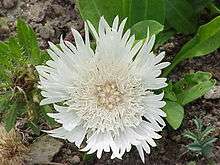Stokesia laevis
| Stokesia laevis | |
|---|---|
 | |
| Scientific classification | |
| Kingdom: | Plantae |
| (unranked): | Angiosperms |
| (unranked): | Eudicots |
| (unranked): | Asterids |
| Order: | Asterales |
| Family: | Asteraceae |
| Tribe: | Vernonieae |
| Genus: | Stokesia L'Héritier de Brutelle |
| Species: | S. laevis (Hill) Greene |
| Binomial name | |
| Stokesia laevis | |
| Synonyms | |
|
Carthamus laevis[1] | |
Stokesia is a monotypic genus of flowering plants in the daisy family, Asteraceae, containing the single species Stokesia laevis. Common names include Stokes' aster and stokesia.[2][3] The species is native to the southeastern United States.
The flowers appear in the summer and are purple, blue, or white in nature.[1] The plant is cultivated as a garden flower. Several cultivars are available, including the cornflower blue 'Klaus Jelitto', 'Colorwheel', which is white, turning purple over time, and 'Blue Danube', which has a blue flower head with a white center.[4] More unusual cultivars include the pink-flowered 'Rosea' and yellow-flowered 'Mary Gregory'.[5]
Like a few other plants (such as some species of Vernonia), it contains vernolic acid, a vegetable oil with commercial applications.[6]
The genus is named after Jonathan Stokes (1755–1831), English botanist and physician.[1]
References
- 1 2 3 Stokesia L’Héritier. Flora of North America.
- ↑ Stokesia laevis. Germplasm Resources Information Network (GRIN).
- ↑ Stokesia laevis. NatureServe. 2012.
- ↑ Stokesia laevis. Missouri Botanical Garden.
- ↑ Stokesia laevis. Floridata.
- ↑ Cahoon, E. B., et al. (2002). Transgenic production of epoxy fatty acids by expression of a cytochrome p450 enzyme from Euphorbia lagascae seed. Plant Physiology 128(2), 615-24.
External links
- Pink, A. (2004). Gardening for the Million. Project Gutenberg Literary Archive Foundation.
- Stokesia laevis. USDA PLANTS.
